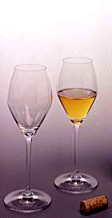Then I asked Kenneth whether they is any Wine bloggers around, he told me none that he known off, cy_miao our resident wine consultant even suggested that why don’t I blog about it myself. At first I hesitated but after giving it a thot, I decided to go ahead with it, so here goes!
Lemme start off with the HISTORY of Ice Wine, there are actually a few version but I’d narrowed it down to 3 and they are :
The History :
1) According to Canadian lore, the first ice wines were made when some winemaker forgot to harvest a few rows of mature grapes on his vineyard's back in the 40s. When he discovered his error, he harvested what was left, pressed the grapes to remove the ice crystals from whatever liquid could be coaxed from the nearly dried, frozen fruit and, voilà, a wine was born.
2) Ice wine originated in Europe two centuries ago when the German farmers of Franconia were hit by a sudden and unexpected winter frost. Rather than discard their frozen grapes, they went ahead and made wine. The result was a small quantity of honey-sweet liquid of high acidity, unlike anything they had ever produced. Eiswein was considered a treasure, yet German conditions have never guaranteed consistency in yield or quality.
3) The discovery of Icewine was accidental. Producers in Franconia, Germany made virtue of necessity by pressing juice from frozen grapes in 1794. They were amazed by the high sugar concentration. It was not until the mid 1800's that Ice wine was intentionally made by the winery. This occured in the Rheingau
So, which one is the real one ? beats me! All of them sounds logical to idiotic me! :P
Most of the world’s famous Ice Wine came from Canada. Outside the wine circles, Canadian ice wine is relatively unknown partly because it can only be produced in a few countries under unique conditions, making it rare and very expensive.
The Process :
Grapes are left on the vine well into the winter months. The resulting freezing and thawing of the grapes dehydrates the fruit, and concentrates the sugars, acids, and extracts in the berries, thereby intensifying the flavours and adding complexity to the wine made from it.
The Ice wine harvest, done entirely by hand, commences once the temperature drops below - 10 to -13 degrees C and the grapes have naturally frozen on the vines. As the frozen grapes are pressed, the natural water portion of the juice remains within the grape skins in the form of ice crystals, and a tiny but precious ration of highly concentrated juice is expressed. The frozen grapes are pressed in the extreme cold, only a few drops of sweet concentrated juice is obtained. This juice is then fermented very slowly for several months, stopping naturally.
The Grapes :
Harvested by hand at night to ensure sunlight does not melt the ice, the grapes must be frozen as hard as marbles. Once picked, they are immediately pressed under strict rules.
Typical grapes used for ice wine production are: Riesling, Seyval, Vidal Blanc, and, interestingly, the red grape Cabernet Franc. Cabernet Franc ice wine is a light pink color, like most rose wines. Conclusion - Ice Wine do not come in RED.
The Taste :
The finished ice wine is intensely sweet and flavourful in the initial mouth sensation. The balance is achieved by the acidity, which gives a clean, dry finish. The nose of icewine recalls lychee nuts. The wine tastes of tropical fruits, with shadings of peach nectar and mango.
The Glass :
The glass, item number 444/55, the sixth in the Vinum Extreme collection of machine-blown, lead-crystal glasses, is 87/8 inches (226mm) high and holds 10 ounces (285ccm).
While a glass can't alter a wine or any other beverage, it does dramatically alter our perception of it. Determining that content should command shape, each Riedel glass is designed after thorough oenological analysis of how different taste characteristics are optimized on the nose and palate by variations in glass design, so that, ultimately, each glass makes a beverage taste its best by enhancing its typicity, authenticity and finest characteristics.
Ice wine glass #444/55
The Companion
Goes with: Cheeses and fruits. It's also a perfect accompaniment to lighter cakes and pastries. Serve it well-chilled.
The Price :
In Europe
An average bottle of Canadian ice wine costs euro 70 but can range from euro 45 to euro 175. A glass in a restaurant can run to around euro 15.
In Malaysia
An Average Bottle of 375ml would cost you somewhere between RM200-RM500 bucks depending on the made and year of the wine.
The Verdict
Wine is the trend now, every ahbeng and ahseng on the block also tried it, they have their own method of drinking it, some add mineral water to it, some add ribena, beers, sodas, you name it. Which is kinda degrading to the serious wine society if you asking me, But nevertheless they bought it and they deserved every rights on how they wanna drink it. :P



Bravo I say... *clapclapclap*
ReplyDelete*suddenly feels more clever*
so.... When are you gonna open your bottle and let me try? :)
Kenneth : *kowtows*
ReplyDeleteAlicia : Thank you, its nice people like you that is fueling my effort to keep on blogging!! *kowtows*
me drink elcheapo wines only. so wingz got wine cooler at home? ;)
ReplyDeleteWah, read liao, drool drool. Next time you belanja ok?
ReplyDeletewah! drink wine never call me! I also like to drink wine! ;)
ReplyDelete